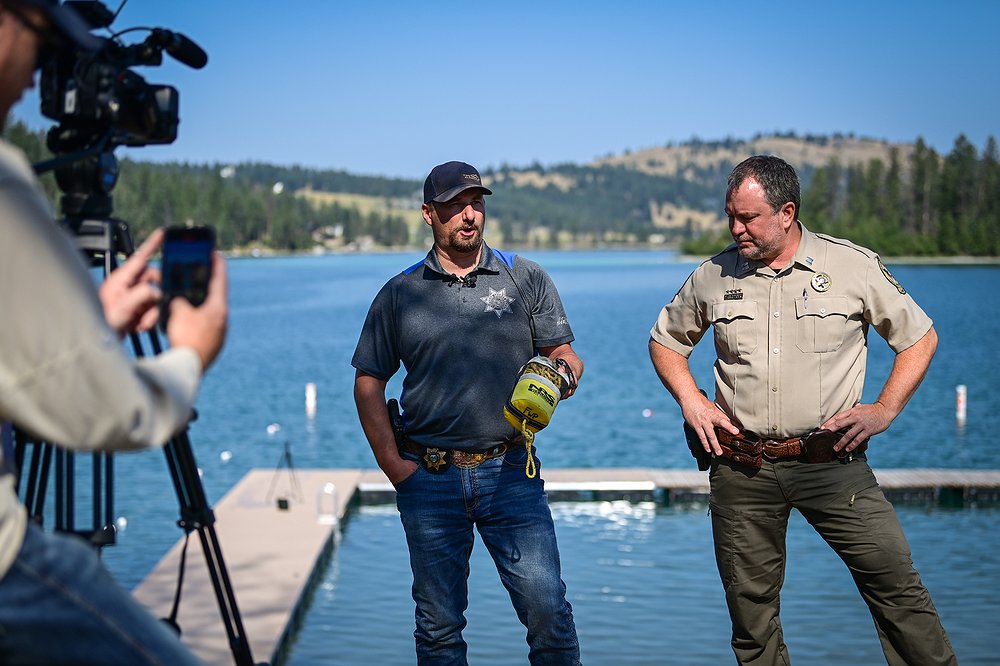Flathead sheriff says use of more advanced sonar is next in search for Emily Rea
Flathead County Sheriff Brian Heino said Thursday that search and rescue teams looking for a paddleboarder missing since July 16 will soon have more advanced sonar at their disposal.
Sound navigation has already been used in the search for Emily Rea, 33, who authorities believe was alone when she put her paddleboard in near the Riverside Boat Launch in the Hungry Horse Reservoir. Along with boat teams equipped with sonar and underwater robots, the Flathead County Sheriff’s Office deployed K9 teams, ground teams, Two Bear Air, drone teams and divers in its efforts to find Rea.
Heino said that an individual from Idaho is bringing a sight scan sonar to aid in the search. The sonar will allow authorities to search at deeper depths.
Rea’s paddleboard was found upside down in the Flossy Creek area, more than 2 miles west of the boat launch, on July 17.
Heino told reporters at the Aug. 15 briefing about lifejacket safety on the shore of Foys Lake that the underwater terrain of the reservoir is difficult to search.
“The challenge we're seeing is the varying terrain, it's 350 feet in some spots, so it's a very dynamic bottom,” Heino said. “But yes, we still have resources out there and we're working with the family, trying to do the best jobs we can out there."
He described the forthcoming sonar equipment as more advanced and said it will be more thorough.
AMID EIGHT boat-related drownings across the state of Montana this year, Heino joined Montana Fish, Wildlife and Parks personnel to remind the public to wear lifejackets, among other safety measures, when playing in the region’s many lakes and rivers.
“We've had a large population growth here in Montana and in this county, so we have a lot more people out, right? The other part is, I think there's a lot of people looking to enjoy the lakes and rivers and streams that we have, so there's more people out there recreating,” Heino said.
Montana Fish, Wildlife and Parks Region 1 Warden Capt. Nathan Reiner said among the eight boat-related drownings this year, six of them involved non-motorized watercraft. Kayakers and paddleboarders still need to wear lifejackets, even if they are capable swimmers, he said.
"You don't know the water temperatures and the effects that's going to have on you, you don't know how the currents will effect you. You might be able to swim in a pool, but when you get out in a cold river with currents, you're better off just not taking a chance and wearing a life jacket,” Reiner said.
Reiner showed a variety of personal floatation devices, including one that is worn as a fanny pack. He said the state wildlife agency operates a lifejacket loaner program at popular fishing sites and state parks.
Kiosks stocked with lifejackets are available at all Flathead Lake state parks as well as the West Glacier River Access Site (on the Middle Fork of the Flathead River) and Glacier Rim River Access Boating Site (on the North Fork of the Flathead River), among others. These are available between Memorial Day and Labor Day each summer.
Reiner said it's important to adjust the lifejacket so there is no room to accidentally slip out of it, particularly if someone is caught in a strong current. With children, Reiner recommended lifting the shoulder straps to ensure a proper fit. There shouldn’t be any wiggle room, he said.
HEINO ALSO emphasized knowing the lay of the land before recreating. Those heading out on Flathead Lake should know the weather conditions can change quickly. People rafting the Flathead River likewise should familiarize themselves with the stretches of white water.
Water in Northwest Montana is typically cold, which makes it more difficult to get out of a situation where there is a risk of drowning, Heino said.
“Our water is colder here in a lot of places. I think that's a big key factor,” he said. “The other one is incidents can occur rapidly. So, if you fall or hit your head or those types of things — we've seen many of those.”
Heino said Flathead County is lucky to have one of the largest volunteer divisions in the entire state. Even with extra resources, they can only handle so many critical calls at the exact same time, he said.
“There's only so many of them, and we're trying to answer all these calls, and they're stacking,” Heino said.
More information about safely recreating on the water can be found on Montana Fish, Wildlife and Park’s website at fwp.mt.gov/activities/boating/safety/.
Reporter Taylor Inman can be reached at 406-758-4433 or by emailing tinman@dailyinterlake.com.





